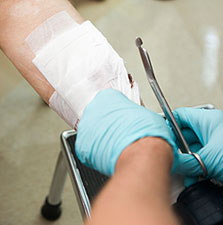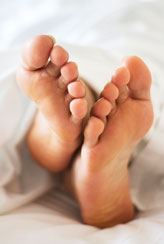









A wound is a break in the skin or tissues that may be caused by an accident, injury, surgery, disease or several other factors, and often involves bleeding, redness, swelling, pain, tenderness and other symptoms. Foot wounds and ulcerations are common conditions, especially in patients with diabetes, who often lose sensation in their feet and can seriously injure themselves without even knowing it.
 Ulcers and wounds may develop on the bottom of the foot as a result of poor circulation, lack of feeling in the feet, irritation or trauma. If they become infected, these lesions can lead to other serious complications, including amputation. Many patients with these conditions face difficulty with the healing process for these troubling wounds and require professional care to reduce the risk of infection and promote proper healing.
Ulcers and wounds may develop on the bottom of the foot as a result of poor circulation, lack of feeling in the feet, irritation or trauma. If they become infected, these lesions can lead to other serious complications, including amputation. Many patients with these conditions face difficulty with the healing process for these troubling wounds and require professional care to reduce the risk of infection and promote proper healing.
Once a wound has been detected, it should be treated immediately in order to prevent complications from developing. Effective wound treatment focuses on relieving pressure from the area and removing dead skin cells and tissue through a process called debridement. The wound is then medicated and dressed to prevent infection and promote healing.
For more severe wounds, patients may be required to wear special footwear or a brace to relieve pressure and irritation to the wound. Surgery may be required in the form of skin grafts to provide medical and cosmetic treatment. To prevent wounds from developing, patients should avoid walking barefoot and keep blood glucose levels under control.
 Corns and calluses are thickened layers of skin that develop on the feet as a result of the skin protecting itself from friction and pressure. These growths tend to appear in those who wear shoes that are too tight or who do not wear socks. Patients with bunions or hammertoes may be at an increased risk of developing these conditions.
Corns and calluses are thickened layers of skin that develop on the feet as a result of the skin protecting itself from friction and pressure. These growths tend to appear in those who wear shoes that are too tight or who do not wear socks. Patients with bunions or hammertoes may be at an increased risk of developing these conditions.
Corns and calluses do not often cause serious medical problems, but they may be painful, especially when walking. Many patients are also bothered by the appearance of these growths, as they appear as a hard, raised bump or a thick, rough area of skin. Corns are smaller than calluses and have a hard center, most often developing on areas of the feet that do not bear weight. They may be painful or tender when pushed. Calluses are larger and develop on the bottom of the feet, most often under the heel or ball of the foot. While not usually painful, they may be of cosmetic concern and should be examined to ensure that no complications occur.
Patients should see their doctor after detecting a corn or callous to determine whether or not it needs to be removed. Patients with diabetes may be at a higher risk of developing complications from these conditions and should seek immediate treatment. Treatment for corns and calluses may include:
Surgery is reserved for only the most severe cases, and involves correcting the alignment of the bone that is causing the problem. In many cases, growths can be treated simply by wearing shoes that fit properly and using protective pads.